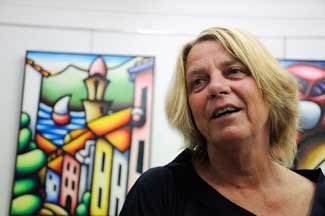The Changing Art Scene in Collioure: Featured Blog Post

Go up a small road lined with art galleries, cafés and souvenir shops, take a left, and you'll find the gallery of Barry Blend, an English painter who has worked in Collioure for about 25 years. His wife, a native of the Netherlands, sits at a desk at the back of the gallery, surrounded by her husband's distinctive, colorful paintings, which are reminiscent of the colorful town they are housed in.
Our first Sunday in France was spent on a day trip to Collioure. Before that Sunday morning, Collioure, like most other French-sounding words, meant nothing to me. Then we arrived, greeted by a small, bustling beachside town, towering green mountains to the right, historic churches to the left—and there, I discovered the definition of picturesque.
Michel Moly, the mayor of Collioure, generously took us on a walking tour of the town that day. The prevalence of art was striking—replicas of famous paintings dotting walls throughout the city, a bar holding around 1,000 pieces of art including a photo of the owner with Pablo Picasso. I didn't know it then, but the significance of art in this small town would become my story.
When I set up the interview with Blend's wife, Tineke, to discuss art in Collioure, I expected her to tell me about how artists go to Collioure because it's brimming with inspiration, how the town lacks a preoccupation with wealth.
But this wasn't the case.
The town has changed since she first came here and met Blend more than 20 years ago. Back then, Tineke said, artists only had to make enough money to pay the rent—and they were happy with that. But now, Tineke believes that art has become more of an industry in Collioure and artists create not for the sake of producing beautiful art, but for the money that tourists will pay for this beautiful art.
Disenchantment suddenly set over me as Tineke discussed the changes in Collioure with a tinge of sorrow in her voice. After my first visit to the town, I imagined it as a magical place for artists, an escape from the real world where people are constantly worrying about money.
But it turns out that my romantic vision of these artists is far from the reality of the situation, and that many of them are after money just like everyone else.
Maybe Collioure is turning into a commercial art Mecca, as Tineke posits. But even if this is true, there will still be the artists who come to Collioure because of the beauty and the light, and those who stay because of it.
Recent Posts
The Cloth of the Sun by Su Kim
The Sculptor and his Wife by Mary Barczak
The Language Barrier by Jim Cameron
The Sixth Sense: Understanding by Christina Cocca
Bastille Day Bees by Annie Petersen
Reaching New Heights by Sarah Raghubir
Vive Perpignan by Chelsea Boone
The Changing Collioure Art Scene by Ariana Bacle
Having a Boule with Pétanque by Kristin O'Brien
Corridas in the 21st Century by Victoria King
Controversy Fermenting? by Marika Washchyshyn
A Different Culinary Landscape by Simon Arseneau
Student Pages
Simon Arseneau
Ariana Bacle
Mary Barczak
Chelsea Boone
Jim Cameron
Christina Cocca
Justine Dhollande
Su Kim
Victoria King
Kristin O'Brien
Annie Petersen
Sarah Raghubir
Alexis Sanchez
Maegan Simmons
Marika Washchyshyn
About the Program
Fifteen college students came from North America to Perpignan, France, in June 2011 to produce these videos and stories. To find out more, read a welcome letter from program director Rachele Kanigel, meet the program faculty and explore the 2010 website.

